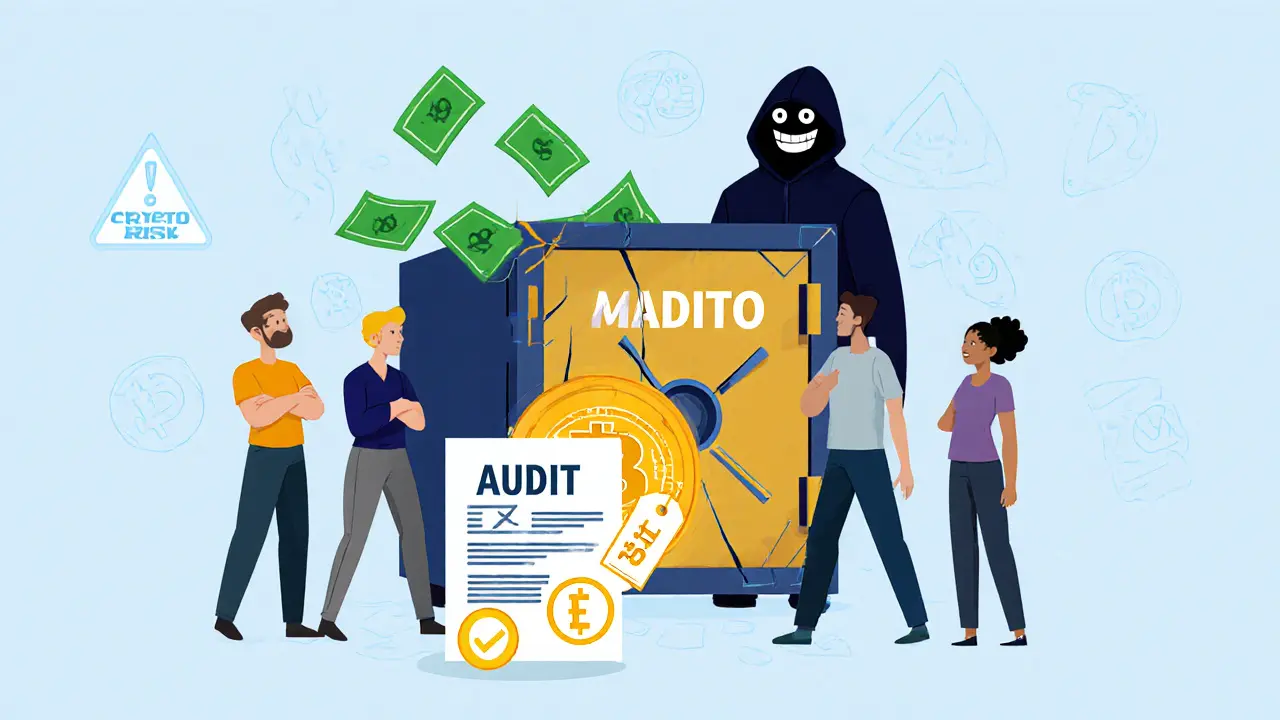Nigeria’s Underground Crypto Economy During the 2021‑2023 Ban
Explore how Nigeria's crypto ban sparked a massive underground P2P market, the platforms that powered it, its economic impact, and what the future holds.
Read More

Get an estimate of your security audit cost based on project type, complexity, and requirements. Note: This estimate reflects 2025 industry standards and includes base audit costs only (re-audit costs not included).
Your estimated audit cost range will appear here
Important: This estimate does NOT include re-audit costs after fixing vulnerabilities. Industry experts recommend budgeting 20-30% extra for remediation cycles.
Skipping a security audit on your crypto project isn’t saving money-it’s gambling with your entire budget. In 2025, a single exploit can wipe out millions in under an hour. The cost of a professional crypto security audit isn’t a line item on your spreadsheet-it’s insurance, reputation protection, and survival. And yes, it’s expensive. But here’s the truth: the cheapest audit you can buy is the one that misses a critical flaw.
There’s no single price tag for a crypto audit. The cost ranges from $1,000 to over $300,000, and it all depends on what you’re building. Simple ERC-20 tokens with basic minting and transfer functions? You’re looking at $1,000 to $20,000. That’s the entry point. But if your token has vesting schedules, fee structures, or automated buybacks, you’re already in the higher end of that range.
Most NFT collections with minting controls, royalty logic, and metadata generation fall into the $15,000 to $50,000 range. If your project includes staking, governance voting, or tokenomics that involve dynamic supply changes, auditors will spend weeks digging through your code. These aren’t just smart contracts-they’re economic systems. And systems that handle money need deep scrutiny.
DeFi protocols? That’s where prices jump. Decentralized exchanges, lending platforms, yield aggregators, and liquidity pools can easily cost $40,000 to $100,000. Why? Because these contracts interact with multiple other contracts, handle large amounts of locked value, and rely on complex price oracles. A single logic error in a swap function or a flawed fee calculation can drain millions. Auditors don’t just check for code bugs-they test for economic attacks, front-running opportunities, and incentive misalignments.
Enterprise-grade projects-multi-chain bridges, DAOs with treasury management, or cross-chain asset wrappers-cost $100,000 to $300,000+. These aren’t just codebases; they’re infrastructure. They connect Ethereum, Solana, Polygon, and others. They manage user funds across chains. One flaw in a bridge contract can lead to irreversible asset loss. That’s why top firms charge premium rates: they’re not just reviewing code-they’re verifying system integrity.
It’s not just about size. Complexity is the real driver. A 500-line ERC-20 contract might cost $5,000. A 20,000-line DeFi protocol with 15 interconnected contracts? That’s $80,000+. Auditors charge by time, and time is spent on manual review. Automated tools catch obvious bugs-reentrancy, overflow, uninitialized variables-but they miss logic flaws. Only a human can spot that your governance proposal system allows a single wallet to propose and vote on the same proposal, or that your fee structure creates a loop where users pay fees to earn fees.
Platform matters too. Solidity on Ethereum is well-understood. There are hundreds of auditors who’ve reviewed thousands of contracts. That competition keeps prices lower. Solana programs in Rust? Fewer experts. That drives prices up. Zealynx.io reports Solana audits are now more expensive than Solidity ones, not because they’re harder to write, but because there are fewer people who can properly audit them.
Reputation adds cost. Trail of Bits, ConsenSys Diligence, and OpenZeppelin don’t just do audits-they’ve found and fixed the flaws that caused major hacks. Their names carry weight. Investors demand them. If you’re raising institutional capital, you won’t get far without one of these firms. Their fees are 30-50% higher than newer firms, but they also come with a track record of catching exploits others miss.
Timeline pressure adds more. If you need your audit in two weeks instead of six, expect a 25-50% surcharge. Audits aren’t fast food. Rushing means missing edge cases. And if you skip the follow-up review after fixing vulnerabilities? That’s like getting your car fixed but not checking if the brakes actually work.
Many firms advertise "starting at $5,000." That’s a trap. That price usually covers only the first audit. It doesn’t include the re-audit after you fix the bugs. And you will fix bugs. Every serious audit finds at least 5-15 issues. Some are minor. Others are critical. You’ll need to patch the code, then pay again to verify the fix.
Industry experts say budget 20-30% extra for remediation cycles. That’s not optional. It’s standard. A $20,000 audit becomes $25,000 after the fix review. A $100,000 audit becomes $125,000. If you’re not planning for this, you’re setting yourself up for failure.
Also, don’t assume the audit report is the end. Top firms include follow-up consultations, clarifications on findings, and guidance on implementation. Budget for that. If you get a 50-page PDF with no explanation, you’re stuck trying to decode it yourself. That’s not value-it’s a liability.

Reddit threads in r/ethereum and r/defi are full of stories. A team spends $3,000 on a budget audit. The contract launches. A week later, $8 million is drained. The exploit? A simple reentrancy bug the auditor missed. The audit report? Three pages long. No diagrams. No explanation of the attack vector. Just a checklist of "passed" automated tests.
That’s not an anomaly. In 2024, over $400 million was lost in exploits on contracts that had been "audited." Most of them used low-cost providers. The common thread? No manual review. No business logic testing. No understanding of tokenomics.
On the flip side, projects that spent $100,000+ on audits from top firms have been attacked-but the exploits failed. Why? Because the auditors found the attack surface before the hackers did. One team using ConsenSys Diligence had a zero-day exploit attempted on their lending protocol. The attacker couldn’t find a path because the audit had already closed all possible vectors.
Community trust matters. Investors check audit reports before investing. Exchanges list tokens only if they’ve been audited by reputable firms. A cheap audit won’t get you listed on CoinGecko or CoinMarketCap. A premium audit? That’s a signal you’re serious.
Most teams spend 5-10% of their total development budget on audits. DeFi projects? They spend 10-15%. That’s not arbitrary. It’s risk-based. If your protocol holds $50 million in TVL, spending $5 million on security is a bargain. Spending $50,000 is a gamble.
Here’s a simple rule: if your project handles more than $1 million in value, don’t go below $20,000. If it handles $10 million or more, $50,000 is the floor. For anything over $100 million, expect $100,000+.
Also, don’t try to cut corners by using the same auditor for multiple projects. Top firms recommend independent audits from different teams for high-risk systems. Why? Because one team might miss something. Two teams? The chance of both missing the same flaw drops dramatically.

You can reduce your audit cost by preparing properly. Clean, well-documented code saves time. If your contracts have clear comments, function descriptions, and flow diagrams, auditors spend less time figuring out what you meant to do. That means lower hours-and lower bills.
Use OpenZeppelin’s libraries. They’ve been audited thousands of times. Reusing proven code reduces your risk and your audit scope. Don’t reinvent the wheel unless you have to.
Run automated tools yourself first. Slither, MythX, and Foundry’s fuzzing tools can catch basic bugs before you even send the code out. That way, the auditor spends time on the hard stuff-not the obvious stuff.
Automated tools are getting better. Since 2024, they’ve reduced basic audit costs by 15-20%. But they’re not replacing humans. They’re just handling the low-hanging fruit. The real threats-economic attacks, incentive misalignments, governance exploits-still need human insight.
As DeFi grows, and regulators demand audits for compliance, costs will keep rising. Experts predict 10-15% annual increases through 2027. That’s not inflation-it’s demand. There aren’t enough skilled auditors to meet the need.
The bottom line? Crypto security audits aren’t optional. They’re mandatory. The cost isn’t the expense-it’s the cost of not doing it. And that’s a price no project can afford to pay.
A basic ERC-20 token audit with simple minting and transfer functions typically costs between $1,000 and $20,000. The exact price depends on features like fee structures, vesting schedules, or automated buybacks. Simple tokens with no complex logic fall toward the lower end, while those with additional economic mechanisms cost more.
Solana audits cost more because there are fewer auditors with deep expertise in Rust and Solana’s unique execution model. Ethereum’s Solidity ecosystem is mature, with hundreds of experienced auditors, creating competition that keeps prices lower. Solana’s newer ecosystem means higher demand and limited supply of qualified reviewers, driving up costs.
Most basic audit quotes do not include follow-up reviews. The initial price typically covers only the first assessment. After you fix reported vulnerabilities, you’ll need to pay again for a re-audit to verify the fixes. Industry experts recommend budgeting an additional 20-30% for this step, as nearly all audits uncover issues requiring code changes.
Even small projects can be targeted. A $50,000 token with a simple contract can still be exploited if it has a logic flaw. Skipping an audit doesn’t save money-it increases the risk of losing everything. Many small projects have lost 100% of their funds because they assumed they were "too small to be hacked." That’s a dangerous myth.
A $10,000 audit usually involves automated tools and a basic manual review of core functions. A $50,000 audit includes deep manual analysis of business logic, economic modeling, edge case testing, interaction with external contracts, and a full report with remediation guidance. The higher price buys expertise, depth, and peace of mind-not just a checklist.
Basic token audits take 2-4 weeks. Intermediate projects like NFT collections or staking systems take 4-8 weeks. Complex DeFi protocols or multi-chain systems can take 8-16 weeks. Timelines often extend if critical vulnerabilities require major code changes and retesting.
Free audits from independent researchers or open-source tools can catch basic bugs, but they lack the depth, accountability, and follow-up of professional audits. Many projects have been exploited after relying on free audits. For any project handling real value, paid audits from reputable firms are the only reliable option.
Yes. Most major exchanges require a security audit from a recognized firm before listing a token. They often specify which auditors they accept-like Trail of Bits, OpenZeppelin, or CertiK. A cheap or unknown audit won’t meet their standards. Listing fees are high, but getting rejected due to poor security is costlier.

Explore how Nigeria's crypto ban sparked a massive underground P2P market, the platforms that powered it, its economic impact, and what the future holds.
Read More
A clear breakdown of NatronZ (NCOIN): what it is, blockchain, tokenomics, market data, how to buy, and key risks for investors.
Read More
FEG Exchange is a niche decentralized exchange built for FEG Token holders. It offers cross-chain bridging and passive rewards but lacks liquidity for major cryptocurrencies. Is it worth using? Here's the real breakdown.
Read More
Write a comment